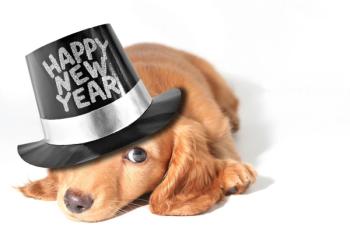
Safe endoscopic removal of a sharp-edged foreign body from a dog's stomach
An 11-year-old spayed female dachshund was referred for evaluation of an acute onset of rear limb paresis.
An 11-year-old 16.5-lb (7.5-kg) spayed female dachshund was referred to Mississippi State University's College of Veterinary Medicine for evaluation of an acute onset of rear limb paresis. On physical examination, the dog had no conscious proprioception or voluntary movement in either rear leg; however, deep and superficial pain were present in both rear legs. All other rear limb reflexes were intact and considered to be normal. The front limbs were neurologically normal. The primary differential diagnosis was a Hansen type-I disk extrusion affecting spinal cord segments T3-L3. No other abnormalities were noted on physical examination. Except for a stress leukogram, hematologic and serum chemistry profile abnormalities were not noted.
Survey spinal radiographs revealed a narrowed disk space at T11-T12, but the myelogram showed extradural compression of the dye column at L2-L3. An incidental finding was a radiopaque triangular foreign body with sharp edges in the stomach lumen (Figure 1). The owners had not observed any clinical signs suggestive of gastrointestinal disease. They also could not recall that the dog had eaten anything abnormal.
1. A lateral survey radiograph revealing a surprising incidental finding: a triangular, radiopaque foreign body in the stomach lumen.
INITIAL SURGERY
The dog was taken to surgery on the day of admission, and a hemilaminectomy was performed at L2-L3. Herniated disk material found in the spinal canal was removed, and 0.75 mg of methylprednisolone sodium succinate was given intravenously. A wait-and-monitor approach to the gastric foreign body was initially taken since it was not an emergent problem and the patient was not exhibiting clinical signs that could be attributed to the foreign body.
The dog made an uneventful recovery, and its neurologic condition slowly improved. By three days postoperatively, the dog could support weight in its rear limbs. The dog's appetite was normal, and no vomiting was noted. Loose stools, but no melena or hematochezia, were observed, and the patient remained hospitalized.
Abdominal radiographs were repeated on day 3 postoperatively to evaluate the location of the foreign body. The foreign body was still in the stomach along with a large volume of food. A decision to remove the foreign body was made even though it was not causing clinical signs because the continued presence of the foreign body in the stomach put the dog at risk for developing gastric lacerations, erosions, ulcers, and peritonitis due to gastric perforation.1,2
SECOND SURGERY
Endoscopic removal would be attempted first, and, if not successful, a gastrotomy would be performed. The procedure was delayed over the weekend because the large amount of food in the stomach at that time made successful endoscopic visualization and removal of the foreign body highly unlikely. Treatment with cimetidine (60 mg orally t.i.d.) and sucralfate (500 mg orally t.i.d.) was initiated. The patient remained hospitalized.
On day 6 after surgery, abdominal radiographs were repeated; the foreign body was still in the stomach. Food had been withheld from the dog for about 12 hours. The dog was anesthetized and positioned in left lateral recumbency for gastroscopy. An Olympus GIF-100 videoendoscope with an external diameter of 9.5 mm was used. The oropharynx and esophagus were grossly normal, and there was no evidence of trauma.
The endoscope was advanced into the stomach. The stomach was then insufflated, which allowed visualization of the greater curvature. A triangular foreign body with sharp edges was seen along the greater curvature; it appeared to be a piece of glass (Figure 2). There were some mucosal erosions around the foreign body, but the rest of the gastric mucosa appeared normal.
2. An endoscopic view of the foreign body lying along the greater curvature of the stomach.
Direct removal of the foreign body with an endoscopic snare or basket forceps was not opted for because the foreign body's sharp edges could potentially have damaged the lower esophageal sphincter or esophagus. Therefore, a large-diameter, close-ended equine stomach tube was modified so that it could be used as a guard or overtube into which the foreign body could be retracted once it was grasped by an endoscopic snare (Figure 3). The stomach tube was cut so that it extended from just beyond the nose to about 10 cm caudal to the last rib and was marked at the length that was needed to enter the stomach. Before oral intubation, the insertion end (cut end of tube) was flamed with a butane lighter to remove any sharp edges. The stomach tube was well-lubricated and slowly advanced into the esophagus. It was somewhat difficult to advance the tube through the lower esophageal sphincter, but, with gentle manipulation, it passed into the stomach. The endoscope was then passed through the tube into the stomach. Since the endoscope did not completely fill the tube's lumen, air quickly leaked out of the stomach. This made it difficult to adequately distend the stomach, and continuous insufflation was necessary throughout the removal procedure.
3. For removal of the foreign body, the endoscope was passed through the lumen of a protective overtube (a modified equine stomach tube).
An endoscopic snare was advanced through the biopsy channel of the endoscope and into the gastric lumen 2 to 4 cm beyond the tip of the endoscope. The snare was extended from its protective sheath and manipulated so that it encircled the foreign body. The snare was then retracted into the sheath until the foreign body was tightly ensnared and pulled securely up against the sheath (Figure 4). To prevent the foreign body from damaging the distal tip of the endoscope, the snare was not retracted into the biopsy channel of the endoscope. Rather, the endoscope and snare were retracted into the overtube until the foreign body was completely within the tube's lumen (Figure 5). The overtube and endoscope were then simultaneously withdrawn. The foreign body was a triangular piece of glass, about 2.5 cm long, with sharp edges (Figure 6).
4. Relative positions of (left to right) the endoscopic snare with its clear sheath, endoscope, and protective overtube within the gastric lumen.
After removal of the foreign body, the endoscope was again advanced into the esophagus and stomach. There were no gross lesions in either structure other than the gastric lesions previously noted on initial insertion of the endoscope. Lesions associated with insertion of the overtube were not observed. The stomach was deflated, and the endoscope was removed.
5. The foreign body was grasped by an endoscopic snare and retracted into the protective overtube to prevent damage to the lower esophageal sphincter and esophagus. To prevent the foreign body from damaging the tip of the endoscope, the endoscopic snare was not retracted into the endoscope.
After endoscopy and foreign body removal, the patient made an uneventful recovery. Treatment with cimetidine and sucralfate was continued until the patient was discharged two days later. Follow-up care for the patient's neurologic problems was provided by the referring veterinarian.
6. The glass foreign body removed from the patient's stomach. The owners were never able to identify where the foreign body came from.
DISCUSSION
Flexible endoscopy is the initial procedure of choice for removing most types of gastric foreign bodies.1 Benefits of this approach include that endoscopic removal can be less invasive and less expensive than a gastrotomy. However, not all gastric foreign bodies are amenable to endoscopic removal.
Criteria that need to be evaluated before endoscopic removal of a foreign body is attempted include the size, shape, sharpness, and makeup or consistency of the foreign body.1,2 In addition, the skill and experience of the endoscopist should be considered.1,2 If a practitioner feels that removal of a foreign body in a particular case may be beyond the extent of his or her endoscopic skills, referral to a facility where endoscopy is more commonly practiced is indicated. Availability of proper instrumentation to manage each case is another factor that must be considered before attempting foreign body removal. For example, endoscopic removal of a hard, smooth, spherical foreign body (e.g. a marble) is unlikely to be successful if a basket snare is not available.2
As demonstrated by this case, another relative contraindication to endoscopic removal of a gastric foreign body is if the object has sharp edges that could potentially damage the lower esophageal sphincter or esophagus when it is removed from the stomach. In patients with sharp-edged esophageal foreign bodies (e.g. fishhooks), endoscopic removal by using a protective cannula is the treatment of choice.1-3 In this procedure, the endoscope is passed through a cannula or overtube into the esophagus, and the foreign body is grasped and retracted into the protective cannula or overtube, allowing for safe removal (Figure 5).1-3 This case report demonstrates how the same procedure can be used to safely remove a sharp-edged foreign body from the stomach.
John W. Tyler, DVM, DACVIM
College of Veterinary Medicine
Western University of Health Sciences
Pomona, CA 91766
REFERENCES
1. Tams TR. Endoscopic removal of gastrointestinal foreign bodies. In: Tams TR, ed. Small animal endoscopy. 2nd ed. St. Louis, Mo.: Mosby, 1999;247-295.
2. Guilford WG. Upper gastrointestinal endoscopy. Vet Clin North Am Small Anim Pract 1990;20(5):1209-1227.
3. Gualtiere M. Esophagoscopy. Vet Clin North Am Small Anim Pract 2001;31(4):605-630.
Newsletter
From exam room tips to practice management insights, get trusted veterinary news delivered straight to your inbox—subscribe to dvm360.




